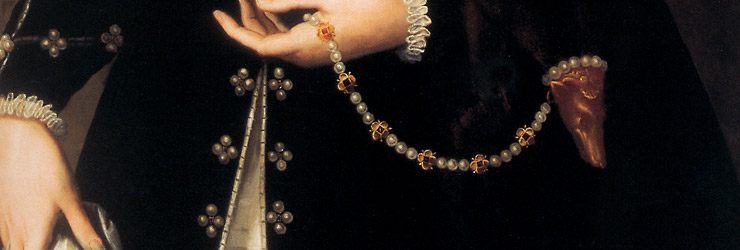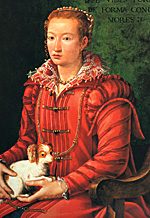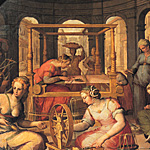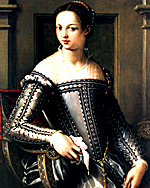
Fabrics
Despite the simplicity of the procedures and the available instruments, the refined professionalism, the knowledge in details of bath preparation and mixtures and temperatures solubility certainly allowed to produce cloths of great merit that often crossed also the borders of the Mediterranean basin as it is shown by fabric swatches arrived up to us and found even in China.

The extraordinary mastery of this complex Dyers Art, and of the so many secrets that were handed down by a generation to another, allowed to produce enormous quantities of cloths; handmade articles that today we still see in numerous pictorial representations of the Renaissance Florence and that can be appreciated for the persistence and the brightness of colours but also for the extraordinary variety of available dyes, had to answer and to adapt themselves to the mutable demands of a very fully developed and in fast growth inside and international market between the XIII and the XIV century.
In the XIII century the first great development of fabric commerce, above all for clothes, began. Florence imported already great quantities of wool fabrics from Flanders. These fabrics were not yet submitted to the last phase of manufacture, and this was done by specialized workers of the famous “Art of Calimala”. Besides this art of solo “finishing”, there was soon the wool workmanship that gave life to a florid international market.
In the XIV century every field, the more and more widespread economic comfort reached by the city and new commercial horizons radically renewed also the fashion that suffered new influences and more and more sophisticated techniques.

The embroidery, for instance, achieved increasing importance, and reached ornamental wealth of such elegance that often appeared in the most famous paintings of the main artists of the time, more and more careful, not only to sacred character scenes, but also to those that represented moments of daily life.
In the same period even velvets were produced with ornamental forms in which floral element and sacred content scenes predominated, in prevalence addressed to ecclesiastics’ clothes. From the second half of the century the increasing diffusion of the Gothic style had a notable influence also on men’s and women’s wear in which prevailed together the sense of verticality and a greater slenderness very evident in the matching of vivacious colours and in the very close- fitting cut. This change in fashion involved a technical evolution and one greater specialization of different arts interested in the process of realization of clothes. In that moment a great deal of models appeared, they were different from the others especially because of details in search of individuality and of evident distinction, and in attempt to represent, especially in the more elevated social classes, the pride of belonging to a society in which they recognized themselves as protagonists.

Besides the textile activities of the silk and wool art, even the tapestry and the embroidery assumed increasing importance. The embroider, combined to the technique of veiled gold on the part to be embroidered, embellished the clothes with admirable effects of light and shade.
In the new artistic knowledge of the century, that tended to search the refined elegance, fabric assumed a solemn aspect in the great length of hangings. The figurative models widened, and passed from the miniature to the bas-relief. Many Italian artists represented these cloths in their pictures with abundance of details. Interesting textile sketches exist, even if we cannot establish if they were projects oriented to pictorial works or if they were true projects for fabrics.
In the XV century Tuscany and Florence were the centre of the most greater and smaller arts, in Italy, and in whole Europe, also as it regards the exhibition of luxury.









